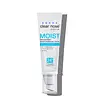What's inside
What's inside
 Key Ingredients
Key Ingredients

 Benefits
Benefits

 Concerns
Concerns

 Ingredients Side-by-side
Ingredients Side-by-side

Water
Skin ConditioningPropanediol
SolventGlycerin
HumectantCaprylic/Capric Triglyceride
MaskingCetearyl Olivate
Niacinamide
SmoothingCaprylyl Glycol
EmollientCeramide NP
Skin ConditioningCeramide AP
Skin ConditioningPhytosphingosine
Skin ConditioningPanthenol
Skin ConditioningCeramide EOP
Skin ConditioningSqualane
EmollientCholesterol
EmollientC13-14 Isoparaffin
EmollientCetyl Palmitate
EmollientPropylene Glycol
HumectantHydrolyzed Sodium Hyaluronate
Skin ConditioningHydrolyzed Hyaluronic Acid
HumectantSodium Hyaluronate
HumectantSodium Acetylated Hyaluronate
HumectantMelaleuca Alternifolia Leaf Extract
PerfumingHamamelis Virginiana Leaf Extract
Skin ConditioningHyaluronic Acid
HumectantPotassium Hydroxide
Buffering1,2-Hexanediol
Skin ConditioningLactic Acid
BufferingVitis Vinifera Seed Oil
EmollientEthylhexylglycerin
Skin ConditioningTocopheryl Acetate
AntioxidantPolyacrylamide
Laureth-7
EmulsifyingCeteareth-12
EmulsifyingSorbitan Olivate
EmulsifyingButylene Glycol
HumectantGlucose
HumectantDisodium EDTA
Cetearyl Alcohol
EmollientHydroxypropyltrimonium Hyaluronate
Potassium Cetyl Phosphate
EmulsifyingSodium Lauroyl Lactylate
EmulsifyingAcrylates/C10-30 Alkyl Acrylate Crosspolymer
Emulsion StabilisingMyristyl Myristate
EmollientXanthan Gum
EmulsifyingGlyceryl Stearate
EmollientCeteareth-20
CleansingCarbomer
Emulsion StabilisingPhenoxyethanol
PreservativeChlorphenesin
AntimicrobialSodium Benzoate
MaskingPotassium Sorbate
PreservativeSodium Hyaluronate Crosspolymer
HumectantPotassium Hyaluronate
Skin ConditioningChondrus Crispus Extract
Skin ConditioningSophora Japonica Flower Extract
Skin ProtectingWater, Propanediol, Glycerin, Caprylic/Capric Triglyceride, Cetearyl Olivate, Niacinamide, Caprylyl Glycol, Ceramide NP, Ceramide AP, Phytosphingosine, Panthenol, Ceramide EOP, Squalane, Cholesterol, C13-14 Isoparaffin, Cetyl Palmitate, Propylene Glycol, Hydrolyzed Sodium Hyaluronate, Hydrolyzed Hyaluronic Acid, Sodium Hyaluronate, Sodium Acetylated Hyaluronate, Melaleuca Alternifolia Leaf Extract, Hamamelis Virginiana Leaf Extract, Hyaluronic Acid, Potassium Hydroxide, 1,2-Hexanediol, Lactic Acid, Vitis Vinifera Seed Oil, Ethylhexylglycerin, Tocopheryl Acetate, Polyacrylamide, Laureth-7, Ceteareth-12, Sorbitan Olivate, Butylene Glycol, Glucose, Disodium EDTA, Cetearyl Alcohol, Hydroxypropyltrimonium Hyaluronate, Potassium Cetyl Phosphate, Sodium Lauroyl Lactylate, Acrylates/C10-30 Alkyl Acrylate Crosspolymer, Myristyl Myristate, Xanthan Gum, Glyceryl Stearate, Ceteareth-20, Carbomer, Phenoxyethanol, Chlorphenesin, Sodium Benzoate, Potassium Sorbate, Sodium Hyaluronate Crosspolymer, Potassium Hyaluronate, Chondrus Crispus Extract, Sophora Japonica Flower Extract
Zinc Oxide
Cosmetic ColorantBenzyl Alcohol 0.39%
PerfumingBenzyl Benzoate 1.01%
AntimicrobialBenzyl Cinnamate 0.15%
PerfumingLanolin 4%
EmollientWater
Skin ConditioningParaffinum Liquidum
EmollientSynthetic Wax
AbrasiveBeeswax
Emulsion StabilisingMicrocrystalline Wax
Emulsion StabilisingSodium Benzoate
MaskingLinalyl Acetate
MaskingPropylene Glycol
HumectantCitric Acid
BufferingBHA
AntioxidantSorbitan Sesquioleate
EmulsifyingParfum
Masking
 Reviews
Reviews

Ingredients Explained
These ingredients are found in both products.
Ingredients higher up in an ingredient list are typically present in a larger amount.
Propylene Glycol is an odorless, colorless liquid. As a humectant, it helps skin retain moisture. It also aids in delivering active ingredients.
Another role of this ingredient is preventing a product from melting or freezing. Propylene glycol also adds antimicrobrial properties to a product, elongating product lifespan.
This ingredient is considered an organic alcohol and commonly added into both cosmetics and foods.
Those with sensitive skin or conditions may develop a rash when using this ingredient.
Learn more about Propylene GlycolSodium Benzoate is a preservative. It's used in both cosmetic and food products to inhibit the growth of mold and bacteria. It is typically produced synthetically.
Both the US FDA and EU Health Committee have approved the use of sodium benzoate. In the US, levels of 0.1% (of the total product) are allowed.
Sodium benzoate works as a preservative by inhibiting the growth of bacteria inside of cells. It prevents the cell from fermenting a type of sugar using an enzyme called phosphofructokinase.
It is the salt of benzoic acid. Foods containing sodium benzoate include soda, salad dressings, condiments, fruit juices, wines, and snack foods.
Studies for using ascorbic acid and sodium benzoate in cosmetics are lacking, especially in skincare routines with multiple steps.
We always recommend speaking with a professional, such as a dermatologist, if you have any concerns.
Learn more about Sodium BenzoateWater. It's the most common cosmetic ingredient of all. You'll usually see it at the top of ingredient lists, meaning that it makes up the largest part of the product.
So why is it so popular? Water most often acts as a solvent - this means that it helps dissolve other ingredients into the formulation.
You'll also recognize water as that liquid we all need to stay alive. If you see this, drink a glass of water. Stay hydrated!
Learn more about Water